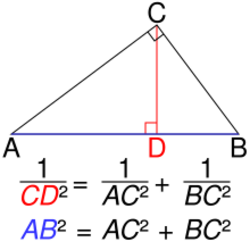| Display title | Inverse Pythagorean theorem |
| Default sort key | Inverse Pythagorean theorem |
| Page length (in bytes) | 5,729 |
| Namespace ID | 0 |
| Page ID | 237924 |
| Page content language | en - English |
| Page content model | wikitext |
| Indexing by robots | Allowed |
| Number of redirects to this page | 0 |
| Counted as a content page | Yes |
| Page image |  |
| HandWiki item ID | None |
| Edit | Allow all users (infinite) |
| Move | Allow all users (infinite) |
| Page creator | imported>MainAI6 |
| Date of page creation | 19:27, 8 February 2024 |
| Latest editor | imported>MainAI6 |
| Date of latest edit | 19:27, 8 February 2024 |
| Total number of edits | 1 |
| Recent number of edits (within past 90 days) | 0 |
| Recent number of distinct authors | 0 |
Description | Content |
Article description: (description)
This attribute controls the content of the description and og:description elements. | In geometry, the inverse Pythagorean theorem (also known as the reciprocal Pythagorean theorem or the upside down Pythagorean theorem) is as follows:
Let A, B be the endpoints of the hypotenuse of a right triangle △ABC. Let D be the foot of a perpendicular dropped from C, the vertex of the right angle... |

